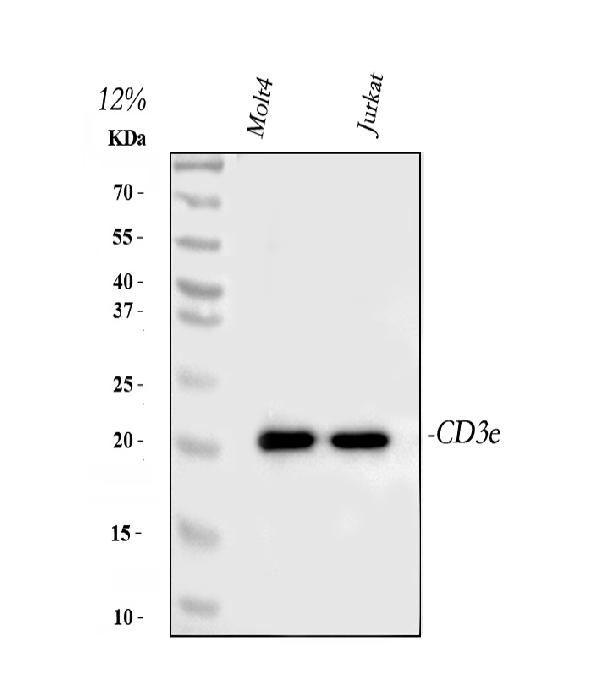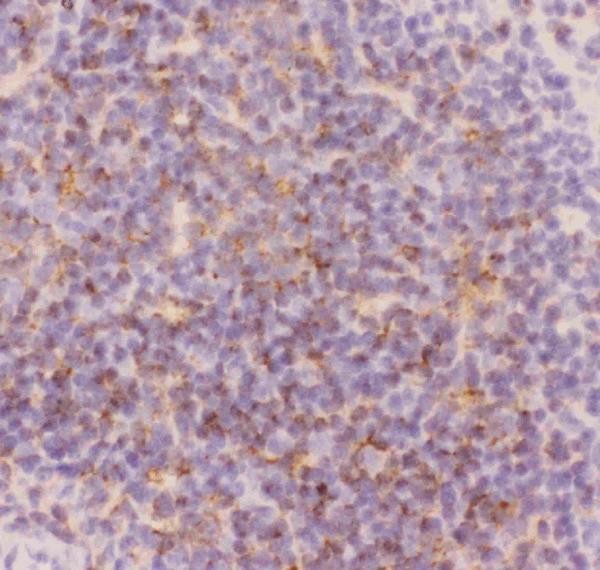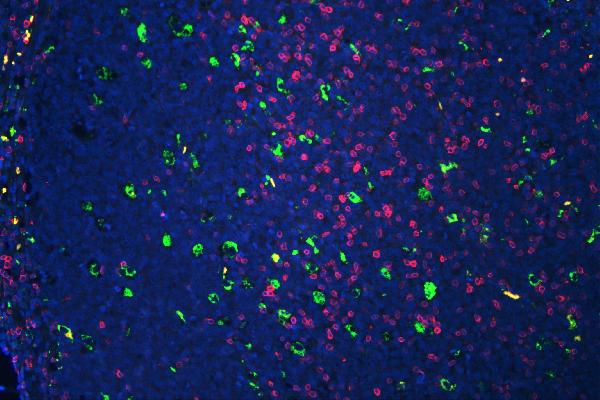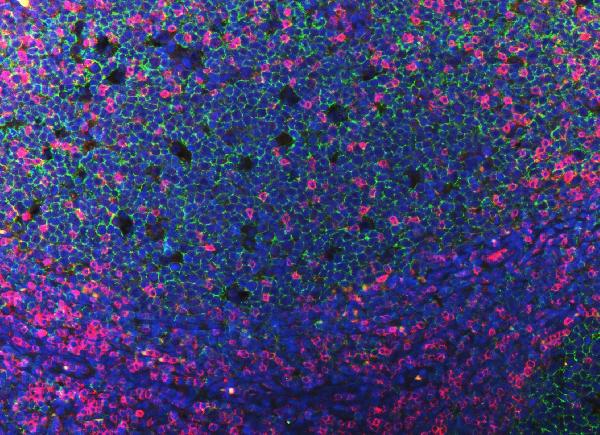Product Info Summary
| SKU: | PB9093 |
|---|---|
| Size: | 100 μg/vial |
| Reactive Species: | Chicken, Human, Mouse, Rat |
| Host: | Rabbit |
| Application: | IF, IHC, IHC-F, ICC, WB |
Customers Who Bought This Also Bought
Product info
Product Name
Anti-CD3 epsilon/CD3E Antibody Picoband®
SKU/Catalog Number
PB9093
Size
100 μg/vial
Form
Lyophilized
Description
Boster Bio Anti-CD3 epsilon/CD3E Antibody Picoband® catalog # PB9093. Tested in IF, IHC, IHC-F, ICC, WB applications. This antibody reacts with Chicken, Human, Mouse, Rat. The brand Picoband indicates this is a premium antibody that guarantees superior quality, high affinity, and strong signals with minimal background in Western blot applications. Only our best-performing antibodies are designated as Picoband, ensuring unmatched performance.
Storage & Handling
Store at -20˚C for one year from date of receipt. After reconstitution, at 4˚C for one month. It can also be aliquotted and stored frozen at -20˚C for six months. Avoid repeated freeze-thaw cycles.
Cite This Product
Anti-CD3 epsilon/CD3E Antibody Picoband® (Boster Biological Technology, Pleasanton CA, USA, Catalog # PB9093)
Host
Rabbit
Contents
Each vial contains 5mg BSA, 0.9mg NaCl, 0.2mg Na2HPO4, 0.05mg NaN3.
Clonality
Polyclonal
Isotype
Rabbit IgG
Immunogen
E.coli-derived human CD3 epsilon recombinant protein (Position: D23-I207). Human CD3 epsilon shares 65% amino acid (aa) sequence identity with mouse CD3 epsilon.
*Blocking peptide can be purchased. Costs vary based on immunogen length. Contact us for pricing.
Cross-reactivity
No cross-reactivity with other proteins
Reactive Species
PB9093 is reactive to CD3E in Chicken, Human, Mouse, Rat
Reconstitution
Add 0.2ml of distilled water will yield a concentration of 500ug/ml.
Observed Molecular Weight
23 kDa
Calculated molecular weight
23147 MW
Background of CD3E
CD3e molecule, epsilon also known as CD3E is a polypeptide which in humans is encoded by the CD3E gene which resides on chromosome 11. It is mapped to 11q23.3. The protein encoded by this gene is the CD3-epsilon polypeptide, which together with CD3-gamma, -delta and -zeta, and the T-cell receptor alpha/beta and gamma/delta heterodimers, forms the T cell receptor-CD3 complex. This complex plays an important role in coupling antigen recognition to several intracellular signal-transduction pathways. The genes encoding the epsilon, gamma and delta polypeptides are located in the same cluster on chromosome 11. The epsilon polypeptide plays an essential role in T-cell development.
Antibody Validation
Boster validates all antibodies on WB, IHC, ICC, Immunofluorescence, and ELISA with known positive control and negative samples to ensure specificity and high affinity, including thorough antibody incubations.
Application & Images
Applications
PB9093 is guaranteed for IF, IHC, IHC-F, ICC, WB Boster Guarantee
Assay Dilutions Recommendation
The recommendations below provide a starting point for assay optimization. The actual working concentration varies and should be decided by the user.
Western blot, 0.1-0.5μg/ml, Human
Immunohistochemistry (Paraffin-embedded Section), 0.5-1μg/ml, Human, Mouse, Rat, Chicken, By Heat
Immunohistochemistry (Frozen Section), 0.5-1μg/ml, Mouse, Rat
Immunocytochemistry , 0.5-1μg/ml, Human
Immunofluorescence, 2μg/ml, Human, Mouse, Rat
Positive Control
WB: human MOLT-4 whole cell, human Jurkat whole cell
IHC: human tonsil tissue, mouse spleen tissue, rat spleen tissue
IHC-F: rat spleen tissue, mouse spleen tissue
IF: human tonsil tissue, human tonsil tissue
Validation Images & Assay Conditions

Click image to see more details
Figure 1. Western blot analysis of CD3E using anti-CD3E antibody (PB9093).
Electrophoresis was performed on a 5-20% SDS-PAGE gel at 70V (Stacking gel) / 90V (Resolving gel) for 2-3 hours. The sample well of each lane was loaded with 30 ug of sample under reducing conditions.
Lane 1: human MOLT-4 whole cell lysates,
Lane 2: human Jurkat whole cell lysates.
After electrophoresis, proteins were transferred to a nitrocellulose membrane at 150 mA for 50-90 minutes. Blocked the membrane with 5% non-fat milk/TBS for 1.5 hour at RT. The membrane was incubated with rabbit anti-CD3E antigen affinity purified polyclonal antibody (Catalog # PB9093) at 0.5 μg/mL overnight at 4°C, then washed with TBS-0.1%Tween 3 times with 5 minutes each and probed with a goat anti-rabbit IgG-HRP secondary antibody at a dilution of 1:5000 for 1.5 hour at RT. The signal is developed using an Enhanced Chemiluminescent detection (ECL) kit (Catalog # EK1002) with Tanon 5200 system. A specific band was detected for CD3E at approximately 23 kDa. The expected band size for CD3E is at 23 kDa.

Click image to see more details
Figure 2. IHC analysis of CD3 Epsilon using anti-CD3 Epsilon antibody (PB9093).
CD3 Epsilon was detected in paraffin-embedded section of human tonsil tissues. Heat mediated antigen retrieval was performed in citrate buffer (pH6, epitope retrieval solution) for 20 mins. The tissue section was blocked with 10% goat serum. The tissue section was then incubated with 1μg/ml rabbit anti-CD3 Epsilon Antibody (PB9093) overnight at 4°C. Biotinylated goat anti-rabbit IgG was used as secondary antibody and incubated for 30 minutes at 37°C. The tissue section was developed using Strepavidin-Biotin-Complex (SABC)(Catalog # SA1022) with DAB as the chromogen.

Click image to see more details
Figure 3. IHC analysis of CD3 Epsilon using anti-CD3 Epsilon antibody (PB9093).
CD3 Epsilon was detected in paraffin-embedded section of mouse spleen tissues. Heat mediated antigen retrieval was performed in citrate buffer (pH6, epitope retrieval solution) for 20 mins. The tissue section was blocked with 10% goat serum. The tissue section was then incubated with 1μg/ml rabbit anti-CD3 Epsilon Antibody (PB9093) overnight at 4°C. Biotinylated goat anti-rabbit IgG was used as secondary antibody and incubated for 30 minutes at 37°C. The tissue section was developed using Strepavidin-Biotin-Complex (SABC)(Catalog # SA1022) with DAB as the chromogen.

Click image to see more details
Figure 4. IHC analysis of CD3 Epsilon using anti-CD3 Epsilon antibody (PB9093).
CD3 Epsilon was detected in paraffin-embedded section of rat spleen tissues. Heat mediated antigen retrieval was performed in citrate buffer (pH6, epitope retrieval solution) for 20 mins. The tissue section was blocked with 10% goat serum. The tissue section was then incubated with 1μg/ml rabbit anti-CD3 Epsilon Antibody (PB9093) overnight at 4°C. Biotinylated goat anti-rabbit IgG was used as secondary antibody and incubated for 30 minutes at 37°C. The tissue section was developed using Strepavidin-Biotin-Complex (SABC)(Catalog # SA1022) with DAB as the chromogen.

Click image to see more details
Figure 5. IHC analysis of CD3 Epsilon using anti-CD3 Epsilon antibody (PB9093).
CD3 Epsilon was detected in frozen section of rat spleen tissues. The tissue section was blocked with 10% goat serum. The tissue section was then incubated with 1μg/ml rabbit anti-CD3 Epsilon Antibody (PB9093) overnight at 4°C. Biotinylated goat anti-rabbit IgG was used as secondary antibody and incubated for 30 minutes at 37°C. The tissue section was developed using Strepavidin-Biotin-Complex (SABC)(Catalog # SA1022) with DAB as the chromogen.

Click image to see more details
Figure 6. IHC analysis of CD3 Epsilon using anti-CD3 Epsilon antibody (PB9093).
CD3 Epsilon was detected in frozen section of mouse spleen tissues. The tissue section was blocked with 10% goat serum. The tissue section was then incubated with 1μg/ml rabbit anti-CD3 Epsilon Antibody (PB9093) overnight at 4°C. Biotinylated goat anti-rabbit IgG was used as secondary antibody and incubated for 30 minutes at 37°C. The tissue section was developed using Strepavidin-Biotin-Complex (SABC)(Catalog # SA1022) with DAB as the chromogen.

Click image to see more details
Figure 7. IF analysis of CD3E and CD68 using anti-CD3E antibody (PB9093) and anti-CD68 antibody (M00602)
CD3E and CD68 was detected in paraffin-embedded section of human tonsil tissues. Heat mediated antigen retrieval was performed in citrate buffer (pH6, epitope retrieval solution ) for 20 mins. The tissue section was blocked with 10% goat serum. The tissue section was then incubated with 1μg/mL rabbit anti-CD3E Antibody (PB9093) and mouse anti CD68 Antibody(M00602) overnight at 4°C. DyLight®488 Conjugated Goat Anti-Mouse IgG (BA1126) and Biotin conjugated goat anti-rabbit IgG (BA1003) were used as secondary antibody at 1:100 dilution and incubated for 30 minutes at 37°C. The tissue section was developed using Cy3 Conjugated Avidin (BA1037). The section was counterstained with DAPI. Visualize using a fluorescence microscope and filter sets appropriate for the label used.

Click image to see more details
Figure 8. IF analysis of CD3E and CD20 using anti-CD3E antibody (PB9093) and anti-CD20 antibody (M03780-5).
CD3E and CD20 was detected in a paraffin-embedded section of human tonsil tissue. Heat mediated antigen retrieval was performed in EDTA buffer (pH 8.0, epitope retrieval solution). The tissue section was blocked with 10% goat serum. The tissue section was then incubated with 2 μg/mL rabbit anti-CD3E antibody (PB9093) and mouse anti-CD20 antibody (M03780-5) overnight at 4°C. DyLight®550 Conjugated Goat Anti-Rabbit IgG (BA1135), DyLight®488 Conjugated Goat Anti-Mouse IgG (BA1126) was used as secondary antibody at 1:100 dilution and incubated for 30 minutes at 37°C. The section was counterstained with DAPI. Visualize using a fluorescence microscope and filter sets appropriate for the label used.
Protein Target Info & Infographic
Gene/Protein Information For CD3E (Source: Uniprot.org, NCBI)
Gene Name
CD3E
Full Name
T-cell surface glycoprotein CD3 epsilon chain
Weight
23147 MW
Alternative Names
T-cell surface glycoprotein CD3 epsilon chain;T-cell surface antigen T3/Leu-4 epsilon chain;CD3e;CD3E;T3E; CD3E IMD18, T3E, TCRE CD3e molecule T-cell surface glycoprotein CD3 epsilon chain|CD3-epsilon|CD3e , epsilon polypeptide (TiT3 complex)|CD3e molecule, epsilon (CD3-TCR complex)|T-cell receptor complex, epsilon subunit of T3|T-cell surface T3/Leu-4 epsilon chain
*If product is indicated to react with multiple species, protein info is based on the gene entry specified above in "Species".For more info on CD3E, check out the CD3E Infographic

We have 30,000+ of these available, one for each gene! Check them out.
In this infographic, you will see the following information for CD3E: database IDs, superfamily, protein function, synonyms, molecular weight, chromosomal locations, tissues of expression, subcellular locations, post-translational modifications, and related diseases, research areas & pathways. If you want to see more information included, or would like to contribute to it and be acknowledged, please contact [email protected].
Specific Publications For Anti-CD3 epsilon/CD3E Antibody Picoband® (PB9093)
Hello CJ!
PB9093 has been cited in 8 publications:
*The publications in this section are manually curated by our staff scientists. They may differ from Bioz's machine gathered results. Both are accurate. If you find a publication citing this product but is missing from this list, please let us know we will issue you a thank-you coupon.
Combination of Chidamide-Mediated Epigenetic Modulation with Immunotherapy: Boosting Tumor Immunogenicity and Response to PD-1/PD-L1 Blockade
Dual-Wavelength Photosensitive Nano-in-Micro Scaffold Regulates Innate and Adaptive Immune Responses for Osteogenesis
Species: Mouse
The pathological features of ectopic lymphoid neogenesis in idiopathic dacryoadenitis
Effect of Hejie decoction on T cell immune state of chronic hepatitis B patients
Chen B, Liu L, Xu H, Yang Y, Zhang L, Zhang F. Exp Ther Med. 2015 Mar;9(3):1063-1067. Epub 2015 Jan 26. Effectiveness Of Immune Therapy Combined With Chemotherapy On The Immune Function And Recurrence Rate Of Cervical Cancer.
Huang J, Zhu C, Zhang P, Zhu Q, Liu Y, Zhu Z, Wang M, Li W, Yang G, Dong N, Liu J, Chen L, Zhang Y, Yang R, Deng L, Fan J, Wang X, Liu J, Ma B, Fu Q, Wu K. Sci Rep. 2013;3:1114. Doi: 10.1038/Srep01114. Epub 2013 Jan 23. S100+ Cells: A New Neuro-Im...
Xie Zj, Jia Lm, He Yc, Gao Jt. World J Gastroenterol. 2006 Mar 21;12(11):1757-60. Morphological Observation Of Tumor Infiltrating Immunocytes In Human Rectal Cancer.
Li Y, Geng S, Yin Q, Chen S, Yang L, Wu X, Li B, Du X, Schmidt Ca, Przybylski Gk. J Transl Med. 2010 May 14;8:47. Doi: 10.1186/1479-5876-8-47. Decreased Level Of Recent Thymic Emigrants In Cd4+ And Cd8+T Cells From Cml Patients.
Recommended Resources
Here are featured tools and databases that you might find useful.
- Boster's Pathways Library
- Protein Databases
- Bioscience Research Protocol Resources
- Data Processing & Analysis Software
- Photo Editing Software
- Scientific Literature Resources
- Research Paper Management Tools
- Molecular Biology Software
- Primer Design Tools
- Bioinformatics Tools
- Phylogenetic Tree Analysis
Customer Reviews
Have you used Anti-CD3 epsilon/CD3E Antibody Picoband®?
Submit a review and receive an Amazon gift card.
- $30 for a review with an image
0 Reviews For Anti-CD3 epsilon/CD3E Antibody Picoband®
Customer Q&As
Have a question?
Find answers in Q&As, reviews.
Can't find your answer?
Submit your question
6 Customer Q&As for Anti-CD3 epsilon/CD3E Antibody Picoband®
Question
Our lab used your anti-CD3 epsilon/CD3E antibody for WB on blood in a previous experiment. I am using mouse, and We want to use the antibody for IHC-P next. We are interested in examining blood as well as thymus in our next experiment. Could you please give me some suggestion on which antibody would work the best for IHC-P?
Verified Customer
Verified customer
Asked: 2020-04-09
Answer
I looked at the website and datasheets of our anti-CD3 epsilon/CD3E antibody and it seems that PB9093 has been tested on mouse in both WB and IHC-P. Thus PB9093 should work for your application. Our Boster satisfaction guarantee will cover this product for IHC-P in mouse even if the specific tissue type has not been validated. We do have a comprehensive range of products for IHC-P detection and you can check out our website bosterbio.com to find out more information about them.
Boster Scientific Support
Answered: 2020-04-09
Question
We are currently using anti-CD3 epsilon/CD3E antibody PB9093 for mouse tissue, and we are content with the IHC-F results. The species of reactivity given in the datasheet says chicken, human, mouse, rat. Is it likely that the antibody can work on monkey tissues as well?
Verified Customer
Verified customer
Asked: 2020-03-13
Answer
The anti-CD3 epsilon/CD3E antibody (PB9093) has not been tested for cross reactivity specifically with monkey tissues, but there is a good chance of cross reactivity. We have an innovator award program that if you test this antibody and show it works in monkey you can get your next antibody for free. Please contact me if I can help you with anything.
Boster Scientific Support
Answered: 2020-03-13
Question
We were content with the WB result of your anti-CD3 epsilon/CD3E antibody. However we have seen positive staining in leukemic t-cell cell membrane using this antibody. Is that expected? Could you tell me where is CD3E supposed to be expressed?
Verified Customer
Verified customer
Asked: 2020-03-11
Answer
From what I have seen in literature, leukemic t-cell does express CD3E. Generally CD3E expresses in cell membrane. Regarding which tissues have CD3E expression, here are a few articles citing expression in various tissues:
Blood, Pubmed ID: 3267235, 15489334
Leukemic T-cell, Pubmed ID: 15144186, 19690332
Thymus, Pubmed ID: 14702039
Boster Scientific Support
Answered: 2020-03-11
Question
We are currently using anti-CD3 epsilon/CD3E antibody PB9093 for mouse tissue, and we are content with the IHC-F results. The species of reactivity given in the datasheet says chicken, human, mouse, rat. Is it likely that the antibody can work on monkey tissues as well?
Verified Customer
Verified customer
Asked: 2019-06-28
Answer
The anti-CD3 epsilon/CD3E antibody (PB9093) has not been tested for cross reactivity specifically with monkey tissues, but there is a good chance of cross reactivity. We have an innovator award program that if you test this antibody and show it works in monkey you can get your next antibody for free. Please contact me if I can help you with anything.
Boster Scientific Support
Answered: 2019-06-28
Question
We have observed staining in chicken leukocyte. What should we do? Is anti-CD3 epsilon/CD3E antibody supposed to stain leukocyte positively?
Verified Customer
Verified customer
Asked: 2018-02-12
Answer
From what I have seen in literature leukocyte does express CD3E. From what I have seen in Uniprot.org, CD3E is expressed in leukocyte, blood, thymus, leukemic t-cell, among other tissues. Regarding which tissues have CD3E expression, here are a few articles citing expression in various tissues:
Blood, Pubmed ID: 3267235, 15489334
Leukemic T-cell, Pubmed ID: 15144186, 19690332
Thymus, Pubmed ID: 14702039
Boster Scientific Support
Answered: 2018-02-12
Question
I would like using your anti-CD3 epsilon/CD3E antibody for pd-1 signaling studies. Has this antibody been tested with western blotting on jurkat whole cell lysate? We would like to see some validation images before ordering.
J. Zhao
Verified customer
Asked: 2014-09-01
Answer
Thank you for your inquiry. This PB9093 anti-CD3 epsilon/CD3E antibody is tested on jurkat whole cell lysate, cem whole cell lysate. It is guaranteed to work for IF, IHC-P, IHC-F, ICC, WB in chicken, human, mouse, rat. Our Boster guarantee will cover your intended experiment even if the sample type has not been be directly tested.
Boster Scientific Support
Answered: 2014-09-01



